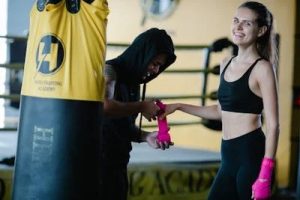Choosing the right punching bag is essential if you want to get the most out of your workout and meet your fitness goals. The type of punching bag you choose can have a big impact on your training regardless of your level of experience. This tutorial is meant to help you understand the many kinds of punching bags and select the one that best fits your needs.
Determine Your Training Goals
Establishing your training objectives is crucial before choosing a punching bag. Are you trying to get better at something like technique, strength, speed, or endurance? What you hope to do will determine the kind of bag you select:
Strength Training: A heavier bag provides more resistance, making it ideal for building strength and power.
Speed and Precision: For improving your speed, timing, and accuracy, a lighter bag or speed bag is more appropriate.
Cardio and Endurance: If increasing cardiovascular fitness and endurance is your aim, think about getting a bag that can handle longer, more intense workouts.
Types of Punching Bags
Punching bags come in a variety of styles, each intended for a particular use in training. Making an informed choice will be made easier if you comprehend these types:
Heavy Bag: Power and strength-focused full-body workouts usually involve the use of a heavy bag. They are available in several weight ranges, often between 70 and 150 pounds. Heavy bags are perfect for power punches and kicks since they are more solid and offer more resistance.
Speed Bag: Speed bags are lighter, smaller bags that are ideal for increasing rhythm, speed, and hand-eye coordination. They are excellent for honing timing and reflexes and are typically mounted at head height.
Freestanding Bag: An adaptable choice that doesn’t require mounting is a freestanding bag. If you’re on a tight budget or just want something portable, this is an excellent alternative. These bags are frequently used for lower-impact strikes and cardio exercises.
Double-End Bag: This kind of bag moves swiftly when struck because elastic cables hold it to the floor and ceiling. Double-end bags are great for defense, timing, and accuracy drills.

Consider Bag Weight and Size
Two important things to think about are the punching bag’s weight and size. The weight of the bag should, in general, be roughly half of your body weight. If you weigh 160 pounds, for instance, a 70–80 pound bag might be suitable. A lighter bag will move more when struck, giving you more opportunity to practice technique and movement. A heavier bag provides greater resistance.
Size is important as well, particularly if you intend to practice kicks. Taller bags offer a greater surface area to target, making them ideal for training combos of punches and kicks.
Material and Durability
The material of the punching bag affects its durability and feel. Common materials include:
- Leather: Serious athletes choose leather backpacks because they are strong and have a natural feel. They are typically more costly, but if you train frequently, the investment is worthwhile.
- Synthetic Leather: Bags made of synthetic leather are less expensive than those made of real leather, and they can nevertheless feel and last well. For those starting off or on a tight budget, they’re a fantastic choice.
- Canvas: The least expensive bags are made of canvas, but they are less sturdy and might be uncomfortable for your hands, particularly if you’re training without gloves.
Space and Installation
When buying a punching bag, take into account the space you have available. Ensure that you have a strong wall mount or ceiling beam before installing a large bag. If you have limited room or don’t want to handle the installation process, freestanding bags are great.
Make sure you have adequate space to maneuver about the bag, particularly if you intend to practice kicks or footwork.
Budget Considerations
Depending on the type, brand, and material, punching bags can cost a lot of money. Decide on a spending plan that fits your objectives and needs. Even though it could be tempting to choose the least expensive choice, if you’re dedicated to your training, spending a little more money on a high-quality bag will pay off in the long run.
Test Before You Buy
Before making a purchase, test out various punching bag varieties if you can. You can test bags at a lot of gyms and sporting goods stores to get a sense of how they react to your blows. To make sure it satisfies your unique requirements and preferences, test the bag.
Conclusion
The punching bag that is best for you will depend on your training objectives, available space, and financial constraints. Choose the right bag to improve your performance and help you meet your fitness goals, whether your focus is on strength, speed, or endurance.
For those seeking quality and durability, the Hayabusa Heavy Bag is an excellent option that can take your training to the next level. To get the most out of your training sessions, put quality first and make sure the bag meets your unique needs.
